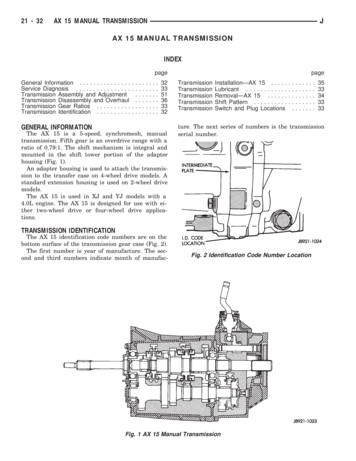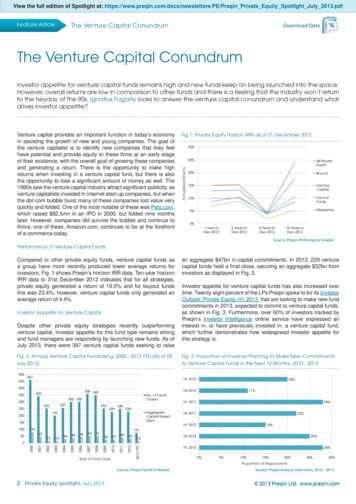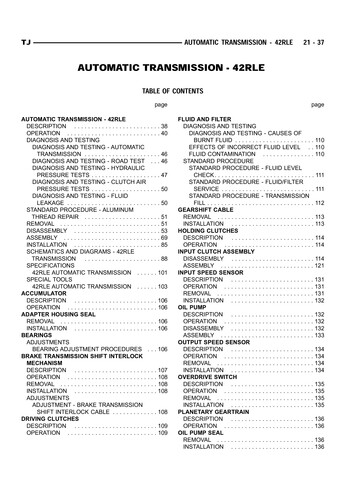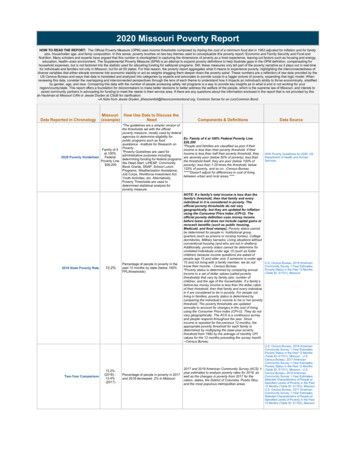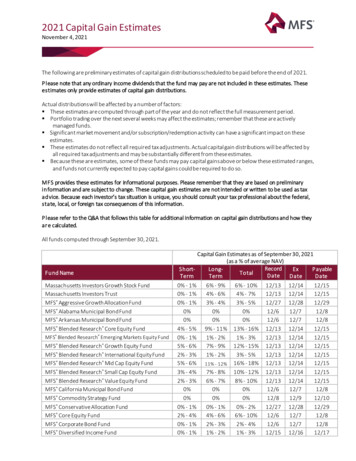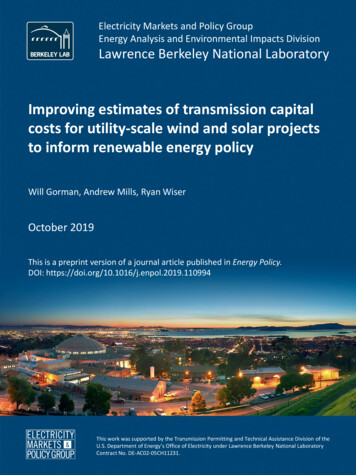
Transcription
Electricity Markets and Policy GroupEnergy Analysis and Environmental Impacts DivisionLawrence Berkeley National LaboratoryImproving estimates of transmission capitalcosts for utility-scale wind and solar projectsto inform renewable energy policyWill Gorman, Andrew Mills, Ryan WiserOctober 2019This is a preprint version of a journal article published in Energy Policy.DOI: https://doi.org/10.1016/j.enpol.2019.110994This work was supported by the Transmission Permitting and Technical Assistance Division of theU.S. Department of Energy’s Office of Electricity under Lawrence Berkeley National LaboratoryContract No. DE-AC02-05CH11231.
DisclaimerThis document was prepared as an account of work sponsored by the United States Government. While thisdocument is believed to contain correct information, neither the United States Government nor any agencythereof, nor The Regents of the University of California, nor any of their employees, makes any warranty,express or implied, or assumes any legal responsibility for the accuracy, completeness, or usefulness of anyinformation, apparatus, product, or process disclosed, or represents that its use would not infringe privatelyowned rights. Reference herein to any specific commercial product, process, or service by its trade name,trademark, manufacturer, or otherwise, does not necessarily constitute or imply its endorsement,recommendation, or favoring by the United States Government or any agency thereof, or The Regents of theUniversity of California. The views and opinions of authors expressed herein do not necessarily state or reflectthose of the United States Government or any agency thereof, or The Regents of the University of California.Ernest Orlando Lawrence Berkeley National Laboratory is an equal opportunity employer.Copyright NoticeThis manuscript has been authored by an author at Lawrence Berkeley National Laboratory under ContractNo. DE-AC02-05CH11231 with the U.S. Department of Energy. The U.S. Government retains, and thepublisher, by accepting the article for publication, acknowledges, that the U.S. Government retains a nonexclusive, paid-up, irrevocable, worldwide license to publish or reproduce the published form of thismanuscript, or allow others to do so, for U.S. Government purposes.
Improving estimates of transmission capital costs forutility-scale wind and solar projects to informrenewable energy policyPrepared for theOffice of Electricity Delivery and Energy ReliabilityNational Electricity DivisionU.S. Department of EnergyPrincipal AuthorsWill Gorman 1Andrew Mills 2Ryan Wiser2Ernest Orlando Lawrence Berkeley National Laboratory1 Cyclotron Road, MS 90R4000Berkeley CA 94720-8136October 2019This work was supported by the Transmission Permitting and Technical Assistance Division of the U.S.Department of Energy’s Office of Electricity under Lawrence Berkeley National Laboratory Contract No.DE-AC02-05CH11231.Lawrence Berkeley National Laboratory, Energy and Resources Group, University of California, Berkeley, CA, USA,wgorman@lbl.gov - Corresponding Author2 Lawrence Berkeley National Laboratory, 1 Cyclotron Road, MS 90-4000, Berkeley, CA 94720, USA1
AcknowledgementsThis work was supported by the U.S. Department of Energy (DOE) under Lawrence Berkeley NationalLaboratory Contract No. DE‐AC02‐05CH11231. We especially thank our DOE sponsors for supportingthis research, and in particular Lawrence Mansueti. We also appreciate early feedback provided by anumber of external advisors on this work. Finally, we thank Rebecca Widiss, Nicholas Disanti, WillCotton, and Kevin Porter from Exeter Associates for their help in the collection and interpretation of theinterconnection study data. Jarett Zuboy provided substantial editing assistance.Author ContributionsW.G. led the research. W.G., A.M., and R.W. designed the analysis framework. W.G. and A.M. led theliterature review. W.G., A.M., and R.W. led the writing of the paper.Competing InterestsThe authors declare no competing interests.Improving estimates of transmission capital costs for utility-scale wind and solar projects to inform renewableenergy policy i
Table of ContentsAcknowledgements. iAuthor Contributions . iCompeting Interests. iTable of Contents . iiTable of Figures . iiiList of Tables . iiiAbstract . iv1. Introduction. 12. Background and Prior Work . 33. Methods . 63.1 Approaches . 63.2 Levelization Calculation . 74. Results . 104.1 Interconnection Costs. 104.1.1 MISO . 104.1.2 PJM . 114.1.3 EIA . 134.1.4 Combined Analysis . 144.2 Bulk System Costs from Actual Projects and Simulation Studies . 154.2.1 Wind . 154.2.2 Solar . 174.3 Aggregated Transmission Costs for Renewables. 194.3.1 California RPS Transmission Cost Aggregation . 194.3.2 U.S.-Wide Transmission Cost Aggregation . 205. Discussion . 236. Conclusions and Policy Implications. 277. References . 28Details of wind studies/costs reviewed . 33Details of solar studies/costs reviewed . 36Additional Information . 39Improving estimates of transmission capital costs for utility-scale wind and solar projects to inform renewableenergy policy ii
Table of FiguresFigure 1. Historical transmission construction. 4Figure 2. Range of levelized costs for selected utility-scale projects in MISO . 11Figure 3. Range of levelized costs for selected utility-scale projects in PJM . 12Figure 4. Range of levelized costs for selected utility-scale projects in EIA dataset . 14Figure 5. Average unit transmission cost by state and utility-scale resource type . 14Figure 6. Average unit cost by queue entry year for constructed utility-scale projects. 15Figure 7. Wind LCOT from constructed and proposed projects and simulation studies . 17Figure 8. Solar LCOT from constructed projects and simulation studies. 19Figure 9. Total U.S. transmission 10-year proposed buildout . 21Figure 10. Estimated U.S. transmission expenditure 1996–2016 . 22Figure 11. Summary of LCOT for utility-scale wind and solar integration . 23Figure A-1. Utility-scale wind chart (at 2% discount rate) . 35Figure B 1. Utility-scale solar chart (at 2% discount rate) . 38List of TablesTable 1. Four approaches to estimating VRE transmission costs . 6Table 2. MISO interconnection costs for selected utility-scale projects. 10Table 3. PJM interconnection costs for selected utility-scale projects. 12Table 4. EIA interconnection costs for selected utility-scale projects . 13Table 5. California transmission projects to meet RPS . 20Table A-1. Source information for wind studies and projects . 33Table A-2. Levelized capital cost of transmission for wind (actual transmission projects) . 34Table A-3. Levelized capital cost of transmission for wind (proposed transmission projects). 34Table A-4. Levelized capital cost of transmission for wind (studies) . 34Table B-1. Source information for utility-scale solar transmission projects and studies . 36Table B-2. Levelized capital cost of transmission for utility-scale solar (studies) . 37Table B-3. Levelized capital cost of transmission for utility-scale solar (actual projects) . 37Table C-1. Capacity Factors Used for Levelization . 39Improving estimates of transmission capital costs for utility-scale wind and solar projects to inform renewableenergy policy iii
AbstractEstimating the overall costs of transmission needed to integrate variable renewable energy (VRE) ontothe grid is challenging. An improved understanding of these transmission costs would support electricitysystem planning as VRE penetrations increase. This paper brackets VRE transmission capital costs usingmultiple approaches based on interconnection studies, actual transmission projects, capacity-expansionsimulation models, and aggregated U.S. VRE-related transmission expenditures. Each approachpossesses advantages and drawbacks, and combining the approaches lends confidence to the results.The resulting range of average levelized VRE transmission costs is 1– 10/MWh, which is generallylower than earlier estimates in the literature. These transmission capital costs can increase the directplant-level levelized cost of VRE by 3%–33%, based on levelized costs of energy of 29– 56/MWh forutility-scale wind and 36– 46/MWh for utility-scale solar. As VRE deployment continues to expand,policy makers can use this information to (1) assess the benefits of transmission avoidance and deferralwhen comparing distributed energy resources versus utility-scale projects, (2) evaluate the potentialcosts of large-scale public transmission investments, and (3) better analyze system-level costs of utilityscale VRE technologies. Future research can expand on the framework presented here by providing areview of operation and maintenance costs for transmission systems.Keywords. Transmission investment; renewable energy; wind; utility solar; levelized cost of energyImproving estimates of transmission capital costs for utility-scale wind and solar projects to inform renewableenergy policy iv
1. IntroductionOver the last decade, variable renewable energy (VRE) technologies, such as wind and solar, haveproliferated in the United States (Bolinger and Seel 2018; Wiser and Bolinger 2017). Numerousstakeholders support continued growth of cost-competitive VRE, and many researchers have studiedthe potential for high VRE penetrations on the electrical grid (Sørensen 2008; BNEF 2018; Elliston,Diesendorf, and MacGill 2012; Connolly et al. 2011; Mathiesen, Lund, and Karlsson 2011; Lund andMathiesen 2009; Liu et al. 2011; Shoshanna 2011; Mai, Hand, et al. 2014) . To make VRE investmentdecisions, policy and electric-sector decision makers face numerous tradeoffs related to locationconstraints, solar/wind resource potential, supporting infrastructure requirements, and so forth (Mills,Phadke, and Wiser 2011). Analysts typically incorporate these tradeoffs into project benefit calculations(estimates of VRE energy and capacity value) and project cost calculations (estimates of VRE integrationcosts such as supply-demand balancing and transmission investment) (Mills and Wiser 2012). Althoughdirect costs are relatively easy to estimate, understanding system-integration costs is more challenging(Ueckerdt et al. 2013). Still, many researchers have attempted to systematically quantify some keysystem-integration costs, such as supply-demand balancing, which results from the variability anduncertainty of VRE energy production (Hirth, Ueckerdt, and Edenhofer 2015; Milligan et al. 2011).Researchers have given less attention to the transmission costs related to VRE grid integration eventhough the levelized transmission infrastructure costs of VRE can be significant (Wiser et al. 2017). Thepotential for higher costs relative to traditional generation resources is due to VRE resource qualitybeing much more location dependent and VRE capacity factors being lower than for traditionalgeneration. Lower capacity factors translates to lower utilization of transmission and a highertransmission cost per unit of energy generated (Mai, Mulcahy, et al. 2014; Kahn 2008; Weiss, Hagerty,and Castaner 2019). Transparent transmission costs would facilitate decisions that support costeffective and fair VRE integration, particularly because electric ratepayers typically bear at least aportion of an electric system’s transmission costs (MISO 2012; Lasher 2014). However, policy makershave limited access to clear, generalizable transmission-cost estimates. Analysts often use levelized costof energy (LCOE) methods to compare the costs of generation resources; however, these relativelysimple methods typically focus on costs up to the busbar only and ignore the complex system wideinfrastructure investments needed to integrate a new resource fully (Lazard 2018); (Rhodes et al. 2017).Estimating transmission costs for VRE integration is difficult, idiosyncratic, and dependent ongeographical context for several reasons. First, it is difficult to attribute costs for system-level assetssuch as transmission infrastructure to individual generation resources. 3 Transmission investmentsgenerally serve multiple purposes, including reliability support and economic congestion relief, whilefacilitating the integration of new generators (EIA 2017). Conventional generators as well as VREresources use expanded transmission networks. Second, immense geographic heterogeneity in systemneeds and costs can make it difficult to generalize costs across different projects. Finally, a project’sAlthough this paper focuses on transmission infrastructure, a review of distribution infrastructure investment was alsoperformed. Those results are available upon request.3Improving estimates of transmission capital costs for utility-scale wind and solar projects to inform renewableenergy policy 1
incremental transmission needs have to be weighed against locations with the best VRE resources. Forexample, siting wind turbines in distant, windy locations that require larger transmission investmentspresents economic tradeoffs versus siting them closer to load where wind resources are poorer(Hoppock and Patiño-Echeverri 2010; Lamy et al. 2016; Silva Herran et al. 2016; Fischlein et al. 2013).Furthermore, liberalized electricity markets frequently present a coordination problem betweeninvestments in the regulated electrical grid (e.g., transmission network) and investments in new powergeneration (Wagner 2019). Project developers may prioritize utility-scale VRE development in highresource areas to improve project economics rather than consider the combination of system-leveltransmission and generation costs that would minimize the overall social cost.Some capacity-expansion models, such as the Regional Energy Deployment System (ReEDS), 4 considergeneration and transmission capacity costs and aim to minimize busbar and system-level costs forelectric-sector planning purposes (Eurek et al. 2016; MacDonald et al. 2016). These models can supportoptimal investment decisions. However, they typically simplify the transmission analysis, and actualtransmission construction may differ from optimized model outcomes, especially because systemplanners rarely can consider transmission and generation investments jointly and holistically.This study fills a gap in existing knowledge by exploring the magnitude of transmission costs for utilityscale wind and solar projects in the United States. It appears to be the first study that uses varioussources to triangulate these costs. Electric-sector stakeholders could use the results to improve gridplanning and assess tradeoffs between VRE resource potential, location, and transmission costs. Section2 provides more background on transmission network investments and summarizes prior estimates oftransmission costs. Section 3 details the study methods. Section 4 presents the results, includinganalysis of interconnection studies (4.1), bulk transmission projects and studies (4.2), and aggregatedtransmission expenditure (4.3). Section 5 discusses the results and limitations. Section 6 concludes withimplications for public policy.Most other capacity-expansion models used by utilities do not jointly optimize transmission and generation capacityinvestments. Other examples that include co-optimization of generation and transmission investments are found in(MacDonald et al. 2016; Nelson et al. 2012; Maloney et al. 2019; Spyrou et al. 2017).4Improving estimates of transmission capital costs for utility-scale wind and solar projects to inform renewableenergy policy 2
2. Background and Prior WorkThe U.S. transmission network is expanded via three main channels. First, regional entities conducttransmission planning processes with the objective of meeting reliability, economic, and/or publicpolicy goals. Second, generation project developers often trigger transmission system expansionthrough generation interconnection requests. Finally, merchant transmission developers propose andconstruct new transmission projects to connect generation projects to consumers. This paper considerscosts from all these channels.Analysts traditionally classify transmission investments into three categories: spur, point ofinterconnection (POI), and bulk transmission. Spur transmission investments are the short, radialtransmission lines that connect generators to the bulk transmission grid. Bulk transmission investmentsare the networked infrastructure investments that move power from all generators to all load centersacross a geographic area. POI investments are the facilities that connect spur transmission lines to bulktransmission grids (Andrade and Baldick 2017).These distinctions relate to how electric-system users bear investment costs. For instance, generationproject developers typically incur costs for spur and POI investments. Generators might also incurnetwork-upgrade costs if an interconnection study identifies necessary bulk system expansion.However, a generation project developer typically will not incur costs from projects developed via thetransmission planning process, such as the Competitive Renewable Energy Zone (CREZ) in Texas andMulti-Value Project (MVP) in Midcontinent Independent System Operator (MISO) territory.This paper focuses on transmission costs for utility-scale wind and solar resources, although traditionalgeneration resources historically have required large transmission investments. Figure 1, which showshistorical transmission buildout peaking in the 1960s and 1970s in part to facilitate a period of baseloadgenerator additions (Fares and King 2017), suggests that large transmission expenditures were neededto integrate new conventional generation (U.S. Department of Energy 2015). Today, economic andpolicy benefits are driving demand for VRE, and high future VRE penetrations likely will require largetransmission investments (Cochran, Mai, and Bazilian 2014; Mai, Hand, et al. 2014).Improving estimates of transmission capital costs for utility-scale wind and solar projects to inform renewableenergy policy 3
Source: DOE QER: Energy Transmission, Storage, and Distribution Infrastructure (2015)Figure 1. Historical transmission constructionPrevious studies have provided some information on VRE-related transmission costs. A review of U.S.transmission planning studies found median wind transmission costs of 15/MWh or 300/kW, roughly15%–20% of a wind project’s cost at the time (Mills, Wiser, and Porter 2012). Two IntergovernmentalPanel on Climate Change reports estimated wind transmission costs of 0– 30/MWh for Organizationfor Economic Co-operation and Development (OECD) countries (Intergovernmental Panel on ClimateChange 2011; 2014). A European study found transmission costs of 7.5– 30/MWh at 30% VREpenetration (Heptonstall, Steiner, and Gross 2017). A study of the MISO service area found wind-relatedtransmission costs of 0.4- 9.7/MWh or 33– 762/kW using interconnection studies (Lamy et al.2016). However, basing costs on interconnection reports tends to neglect the costs of region-widetransmission investments. A study of the western United States found transmission costs of 9/MWh or 314/kW when considering the integration of wind, solar, geothermal, biomass, and hydro resources(Mills, Phadke, and Wiser 2011). Finally, a study of utility-scale wind and solar transmission costs foundcosts of 0.83– 75/MWh for proposed western U.S. projects, with wind transmission costs often atleast 20/MWh (Kahn 2010; 2008).The present study builds on this existing literature. It benefits from the availability of more VRE-relatedtransmission data, because utility-scale wind and solar energy deployment has grown rapidly in the last10 years (EIA 2019). In previous studies, many project costs were based on budget estimates ormodeling rather than the actual project costs this paper can take advantage of. The present study alsotakes a more comprehensive approach to all transmission needed for utility-scale wind and solar energybuildout, drawing on interconnection studies, actual transmission projects, simulation/optimizationImproving estimates of transmission capital costs for utility-scale wind and solar projects to inform renewableenergy policy 4
models, and aggregated U.S. utility-scale wind and solar transmission expenditures. This multifacetedapproach enables realistic system-level cost estimates. Finally, this study’s integration of utility-scalewind and solar transmission costs enables comparison of transmission requirements between the tworesource types, whereas most previous studies focused on only one of these types.Improving estimates of transmission capital costs for utility-scale wind and solar projects to inform renewableenergy policy 5
3. MethodsThis section describes the study’s approaches to transmission-cost estimation and its levelizedtransmission cost calculations.3.1 ApproachesThis study combines four complementary approaches to provide robust estimates of VRE transmissioncosts (Table 1). The interconnection study approach draws on studies from two regional transmissionoperators—PJM in the East and MISO in the Midwest—as well as the U.S. Energy InformationAdministration (EIA) Form 860 interconnection costs from 2005–2012 (EIA 2018c). These sources covermany planned and built generation projects over the past 10 years. In general, they include POI andbulk system costs required for transmission interconnection that are assigned to particular generators.They do not include spur transmission line costs. In addition to facilitating transmission cost attribution,this is the only approach of the four that enables comparison of costs related to VRE and non-VREresources. However, interconnection studies do not always include bulk transmission investmentsassociated with delivering significant amounts of electricity across long distances.Table 1. Four approaches to estimating VRE transmission costsThe other three approaches address these large bulk transmission costs. The actual project approachbenefits from using cost data for built or proposed large-scale transmission projects that havecorresponding estimates of VRE capacity integration. However, compared with the interconnectionstudy approach, this approach provides less information about cost attribution to particular generationresources versus other transmission investment drivers such as reliability and economic congestionrelief. Furthermore, although project capital costs are generally transparent and concrete, the amountof VRE integrated owing to the transmission investment can be ambiguous and difficult to determine.Improving estimates of transmission capital costs for utility-scale wind and solar projects to inform renewableenergy policy 6
The simulation study approach draws on regional grid-modeling studies that estimate directly thetransmission investments needed to integrate VRE. In contrast with the actual project approach—whichentails selection bias because only VRE projects requiring long-distance transmission are included—thesimulation study approach accounts for VRE that does and does not need new transmission forsuccessful integration. However, the simulation study approach relies on equipment cost assumptionsthat may be imprecise 5, and it typically uses optimization to estimate the lowest-cost (but oftenunrealized in practice) solution.The aggregation approach uses the actual transmission costs needed to integrate VRE in California andnationwide. The California costs are estimated using California Energy Commission (CEC) data ontransmission investments related to renewable portfolio standard (RPS) compliance (CEC 2018),California’s cumulative VRE deployment, California Public Utilities Commission records, budgets ofcompleted projects, and Edison Electric Institute (EEI) reports. Compared with the other approaches,this approach provides more certainty that transmission costs are primarily related to VRE integrationbecause CEC states that listed transmission projects were required for RPS compliance. In addition, thisapproach enables estimation of the total regional transmission costs associated with integrating all VREand thus avoids the selection bias that occurs when estimates are based on individual projects.Finally, aggregated national cost estimates draw on data from EIA Form 411, EEI, and EIA’s electricpower monthly dataset. EIA Form 411, which is compiled by the North American Electric ReliabilityCorporation (NERC), contains data on proposed high-voltage transmission projects back to the early2000s and reports reasons for transmission buildout (e.g., reliability, VRE integration, economics, nonrenewable integration) starting in 2008 (EIA 2017). The historical capital cost of transmission for VRE iscalculated based on the amount of proposed VRE-driven transmission and EEI’s estimate of historicaltransmission investment. Then, EIA’s data on total amount of U.S. VRE generation installed are used tocalculate a levelized capital cost of the transmission infrastructure.3.2 Levelization CalculationThis study calculates the levelized capital cost of transmission (LCOT) mainly by dividing the annualizedcapital cost of a transmission project or aggregation of projects (left term of equation 1) by the amountof annual VRE estimated to
costs for utility-scale wind and solar projects to inform renewable energy policy. Will Gorman,Andrew Mills, Ryan Wiser. . MS 90R4000 . Berkeley CA 94720 -8136 . . have limited access to clear, generalizable transmission -cost estimates. Analysts often use levelized cost of energy (LCOE) methods to compare the costs of generation resources .

